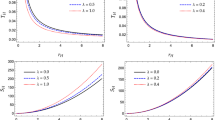Abstract
Classical invariants of General Relativity can be used to approximate the entropy of the gravitational field. In this work, we study two proposed estimators based on scalars constructed out from the Weyl tensor, in Kerr spacetime. In order to evaluate Clifton, Ellis and Tavakol’s proposal, we calculate the gravitational energy density, gravitational temperature, and gravitational entropy of the Kerr spacetime. We find that in the frame we consider, Clifton et al.’s estimator does not reproduce the Bekenstein–Hawking entropy of a Kerr black hole. The results are compared with previous estimates obtained by the authors using the Rudjord–Gr\(\varnothing \)n–Hervik approach. We conclude that the latter represents better the expected behaviour of the gravitational entropy of black holes.







Similar content being viewed by others
Notes
Since the Bel–Robinson tensor has dimensions of \(L^{-4}\), it is necessary to take the square of this quantity to obtain energy densities and pressures with the correct dimensionality [16].
For a formal definition of improper integral see the Appendix and Ref. [25].
Let \(\Omega \subseteq \mathfrak {R}^{p}\) be a non-compact domain for which each bounded part of the frontier is negligible. We say that the sequence \(\left( D_{\mathrm{n}}\right) _{n \in \mathbb {N}}\) of measurable compact domains is exhausting \(\Omega \) iff for any compact \(K \subset \Omega \) there exists \(n_{0} \in \mathbb {N}\) such that \(K \subset D_\mathrm{n}\) for all \(n \ge n_{0}\).
References
Hawking, S.W.: Black hole explosions? Nature 248, 30–31 (1974)
Hawking, S.W.: Particle creation by black holes. Commun. Math. Phys. 43, 199–220 (1975)
Bekenstein, J.D.: Black holes and the second law. Lett. Nuovo Cimento 4, 737–740 (1972)
Bekenstein, J.D.: Black holes and entropy. Phys. Rev. D 7, 2333–2346 (1973)
Bekenstein, J.D.: Generalized second law of thermodynamics in black holes. Phys. Rev. D 9, 3292–3300 (1974)
Bardeen, J.M., Carter, B., Hawking, S.W.: The four laws of black hole mechanics. Commun. Math. Phys. 31, 161–170 (1973)
Penrose, R.: General relativity, an Einstein centenary survey. In: Hawking, S.W., Israel, W. (eds.) Singularity and Time-Asymmetry, pp. 581–638. Cambridge University Press, Cambridge (1979)
Rudjord, Ø., Grøn, Ø., Hervik, S.: The Weyl curvature conjeture and black hole entropy. Phys. Scr. 77(5), 055901 (2008)
Clifton, T., Ellis, G.F.R., Tavakol, R.: A gravitational entropy proposal. Class. Quantum Gravity 30, 125009 (2013)
Bel, L.: Sur la radiation gravitationnelle. C. R. Acad. Sci. 247, 1094–1096 (1958)
Bel, L.: Introduction d’un tenseur du quatrieme order. C. R. Acad. Sci. 248, 1297 (1959)
Robinson, I.: Unpublished lectures at King College, London (1958)
Robinson, I.: On the Bel–Robinson tensor. Class. Quantum Gravity 14, 4331 (1997)
Breton, N., Feinstein, A., Ibañez, J.: The Bel–Robinson tensor for the collision of gravitational plane waves. Gen. Relativ. Gravit. 25, 267–273 (1993)
Krishnasamy, I.: Quasilocal energy and the Bel–Robinson tensor. Gen. Relativ. Gravit. 17, 621–627 (1985)
Bonilla, M.A.G., Senovilla, J.M.M.: Some properties of the Bel and Bel-Robinson tensors. Gen. Relativ. Gravit. 29, 91–116 (1997)
Unruh, W.G.: Notes on black-hole evaporation. Phys. Rev. D 14, 870–892 (1976)
Gibbons, G.W., Hawking, S.W.: Cosmological event horizons, thermodynamics, and particle creation. Phys. Rev. D 15, 2738–2751 (1977)
Doran, C.: A new form of the Kerr solution. Phys. Rev. D 61, 067503 (2000)
Gullstrand, A.: Allgemeine lösung des statichen einkörperproblems in der Einsteinschen gravitationstheorie. Arkiv. Mat. Astron. Fys. 16, 1–15 (1922)
Painlevé, P.: La mécanique classique et la théorie de la relativité. C. R. Acad. Sci. Paris 173, 677–680 (1921)
Wald, R.M.: General Relativity. The University of Chicago Press, Chicago (1984)
Garat, A., Price, R.H.: Nonexistence of conformally flat slices of the Kerr spacetime. Phys. Rev. D 61, 124011 (2000)
Visser, M.: Lorentzian Wormholes: From Einstein To Hawking. AIP Series in Computational and Applied Mathematical Physics. Springer, New York (1996)
Courant, R.: Differential and Integral Calculus, vol. II. Blackie & Son, Great Britain (1961)
Predoi, M., Blan, T.: Mathematical analysis, vol. II. Integral Calculus. Editura Universitaria, Craiova (2005)
Romero, G.E., Thomas, R., Pérez, D.: Gravitational entropy of black holes and wormholes. Int. J. Theor. Phys. 51, 925–942 (2012)
Acknowledgments
This work is supported by PICT 2012-00878, Préstamo BID (ANPCyT). We thank Santiago E. Perez Bergliaffa for useful advice.
Author information
Authors and Affiliations
Corresponding author
Appendix
Appendix
1.1 Definition of improper integral
Let \(\Omega \subseteq \mathfrak {R}^{p}\) be a non-compact domain, and let \(f: \Omega \rightarrow \mathfrak {R}\) be integrable on each measurable compact domain \(D \subset \Omega \). We say that \(f\) is improperly integrable on \(\Omega \) iff for every increasing sequence of measurable compact domains, \(\left( D_{\mathrm{n}}\right) _{n \in \mathbb {N}}\), which is exhaustingFootnote 4 \(\Omega \), the secuence:
is convergent. In such a case we note:
and we call it improper integral of \(f\) on \(D\). Alternatively we say that the integral of \(f\) on \(\Omega \) is convergent [26].
1.2 Proof of the divergence of the improper integral:
where
Since \(h_{i}(r)\) does not depend on \(\theta \), we can simply integrate (57) on this coordinate:
where,
The function \(1/\gamma _{i} \left( r_{*}-r\right) \) diverges at \(r = r*\). We define a subsequence of closed subregions \(R_\mathrm{n}\) where the latter integral is well-defined:
with \(n \in {\mathbb N}\), such that
We integrate the function \(1 = 1/h_{i}(r)\) over the domain \(R_{n}\) as follows:
The limit of the latter equation when \(n \rightarrow \infty \) does not exist. Therefore, the integral given by Eq. (57) is divergent.
Rights and permissions
About this article
Cite this article
Pérez, D., Romero, G.E. Gravitational entropy of Kerr black holes. Gen Relativ Gravit 46, 1774 (2014). https://doi.org/10.1007/s10714-014-1774-3
Received:
Accepted:
Published:
DOI: https://doi.org/10.1007/s10714-014-1774-3




